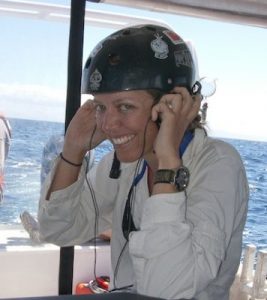Alison Stimpert, Ph.D.
Research Faculty
 My primary interests lie in the intersection of bioacoustics and conservation. To study this, I use suction-cup acoustic tags to correlate sound production with underwater behavior of marine mammals. Currently, I am focusing on the effects of anthropogenic sound on the social behavior and foraging ecology of several cetacean species in southern California as part of the Southern California Behavioral Response Study (SOCAL BRS). This is in addition to maintaining a long time research program on humpback whale acoustic behavior, which has included work in the waters around Hawaii, Massachusetts, Alaska, and Antarctica. Gaining an understanding of the behavioral context of whale sound production will aid our interpretation of how anthropogenic sound in the ocean may affect whale populations, and can also be used in conservation and management strategies for remote monitoring of whale behavior and movements.
My primary interests lie in the intersection of bioacoustics and conservation. To study this, I use suction-cup acoustic tags to correlate sound production with underwater behavior of marine mammals. Currently, I am focusing on the effects of anthropogenic sound on the social behavior and foraging ecology of several cetacean species in southern California as part of the Southern California Behavioral Response Study (SOCAL BRS). This is in addition to maintaining a long time research program on humpback whale acoustic behavior, which has included work in the waters around Hawaii, Massachusetts, Alaska, and Antarctica. Gaining an understanding of the behavioral context of whale sound production will aid our interpretation of how anthropogenic sound in the ocean may affect whale populations, and can also be used in conservation and management strategies for remote monitoring of whale behavior and movements.
Please feel free to visit my website for more information: www.stimpert.com/alison
Selected Publications:
Goldbogen, J.A., Calambokidas, J., Friedlaender, A.S., Francis, J., DeRuiter, S.L., Stimpert, A.K., Falcone, E., Southall, B.L. 2013. Underwater acrobatics by the world’s largest predator: 360 degree rolling manoeuvers by lunge feeding blue whales. Biology Letters (9)1.
Stimpert, A.K., Peavey, L.E., Friedlaender, A.S., Nowacek, D.P. 2012. Humpback whale song and foraging behavior on an Antarctic feeding ground. PLOS One 7(12): e51214. doi:10.1371/journal.pone.0051214 (includes supplementary sound files)
Stimpert, A.K., Mattila, D., Au, W.W.L., Nosal, E.M. 2012. Tagging young humpback whale calves: methodology and underwater behavior. Endangered Species Research 19: 11-17, DOI 10.3354/esr00456.
Tyson, R.B., Friedlaender, A.S., Ware, C., Stimpert, A.K., Nowacek, D.P. 2012. In synch? Humpback whale mother and calf foraging behavior: insights from multi-sensor suction cup tags. Marine Ecology Progress Series 457: 209-220.
Apprill A, Mooney T.A., Lyman E., Stimpert A.K., Rappé M.S. 2011. Humpback whales harbour a combination of specific and variable skin bacteria. Environmental Microbiology Reports 3:223-232.
Stimpert, AK, Au, WWL, Parks, SE, Hurst, T, Wiley, DN. 2011. Common humpback whale (Megaptera novaeangliae) sound types for passive acoustic monitoring. Journal of the Acoustical Society of America 129(1): 476-482.
Stimpert, A.K., Wiley, D.N., Au, W.W.L., Johnson, M.P., and Arsenault, R. 2007. “Megapclicks”: acoustic click trains and buzzes used during nighttime foraging of humpback whales (Megaptera novaeangliae). Biology Letters 3(5): 467-470.

